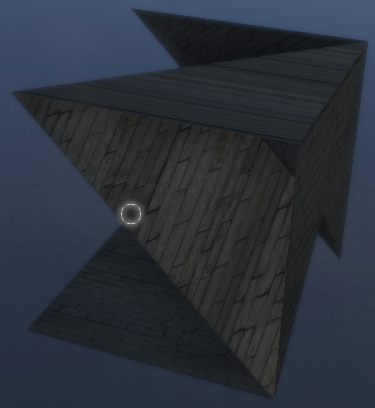I'm trying to implement the Bowyer-Watson point insertion version of the Delaunay triangulation algorithm, but in 3D. I previously implemented the 2D version without problems, but when transitioning to 3D using Tetrahedrons instead of Triangles (and triangles instead of edges), I don't get proper triangulation.
For instance, given 8 points defining the corners of a unit cube (-1,-1,-1 through to 1,1,1), I get the following result:
A summary of the algorithm:
- Create a super tetrahedron that encapsulates all of my points and add it to a tetrahedron list.
- One at a time, check each point against the circumsphere of each tetrahedron in the list, copying its triangles.
- Delete all tetrahedrons who were intersected
- Delete all duplicate triangles in the list
- Using each remaining triangle, form new tetrahedron from triangle's 3 points + the new point
After iterating through all points, delete all tetrahedrons that share a vertex with the starting super tetrahedron
vector<vec3> Geometry_Tools::Delaunay_Triangulate(const vector<vec3>& points) { vector<Tetrahedron> tetrahedrons; vec3 p1, p2, p3, p4; Calculate_Supertetrahedron(points, p1, p2, p3, p4); tetrahedrons.push_back(Tetrahedron(p1, p2, p3, p4)); // Add the points one at a time, branch tetrahedrons off of it. for (auto point = begin(points); point != end(points); point++) { // Mark all the tetrahedrons which contain this point for deletion, grab their triangles too. vector<Tetrahedron> badTetrahedrons; vector<Triangle> triangles; for (auto tetrahedron = begin(tetrahedrons); tetrahedron != end(tetrahedrons); tetrahedron++) { if (tetrahedron->CS_Contains_Point(*point)) { badTetrahedrons.push_back(*tetrahedron); triangles.push_back(tetrahedron->faces[0]); triangles.push_back(tetrahedron->faces[1]); triangles.push_back(tetrahedron->faces[2]); triangles.push_back(tetrahedron->faces[3]); } } // Delete all the invalid tetrahedrons in 1 pass tetrahedrons.erase(std::remove_if(begin(tetrahedrons), end(tetrahedrons), [badTetrahedrons](Tetrahedron &tetrahedron) { for (auto invalidTetrahedron = begin(badTetrahedrons); invalidTetrahedron != end(badTetrahedrons); invalidTetrahedron++) if (*invalidTetrahedron == tetrahedron) return true; return false; }), end(tetrahedrons)); // All the duplicate triangles cancel each other out and aren't needed. Find and mark them for deletion. vector<Triangle> badTriangles; for (auto e1 = begin(triangles); e1 != end(triangles); e1++) { for (auto e2 = begin(triangles); e2 != end(triangles); e2++) { // We are reading the same list twice, so skip if the itterators are the same if (e1 == e2) continue; if (*e1 == *e2) { badTriangles.push_back(*e1); badTriangles.push_back(*e2); } } } // Delete all the invalid triangles in 1 pass. Creates the hole we need to insert the point. triangles.erase(std::remove_if(begin(triangles), end(triangles), [badTriangles](Triangle &triangle) { for (auto invalidTriangle = begin(badTriangles); invalidTriangle != end(badTriangles); invalidTriangle++) if (*invalidTriangle == triangle) return true; return false; }), end(triangles)); // What remains is an triangle which when used with point == new tetrahedron for each (const auto &triangle in triangles) tetrahedrons.push_back(Tetrahedron(triangle.p0, triangle.p1, triangle.p2, *point)); } // Delete the contribution of the original super tetrahedron. // If a tetrahedron shares a point with the original super tetrahedron, then it should be deleted tetrahedrons.erase(std::remove_if(begin(tetrahedrons), end(tetrahedrons), [p1, p2, p3, p4](Tetrahedron &tetrahedron) { return tetrahedron.Contains_Vertex(p1) || tetrahedron.Contains_Vertex(p2) || tetrahedron.Contains_Vertex(p3) || tetrahedron.Contains_Vertex(p4); }), end(tetrahedrons)); vector<vec3> vertices; vertices.reserve(tetrahedrons.size() * 3); for each (const auto &tetrahedron in tetrahedrons) { for each (const auto &triangle in tetrahedron.faces) { vertices.push_back(triangle.p0); vertices.push_back(triangle.p1); vertices.push_back(triangle.p2); } } return vertices; }
Can anyone help me solve my problem?
I've verified that I'm calculating the circumsphere correctly; I double checked the formula and my implementation & visualizing the sphere against the tetrahedron.
It seems like most of the final tetrahedrons share 2-3 points with the boundary super tetrahedron. I don't know why so few new tetrahedra between the data points exist...

